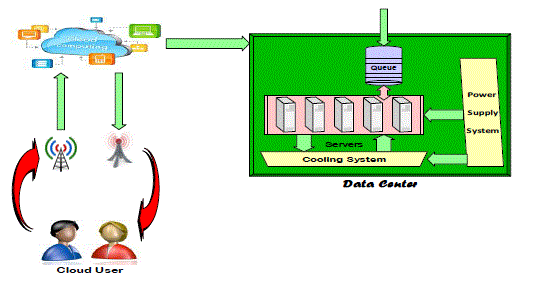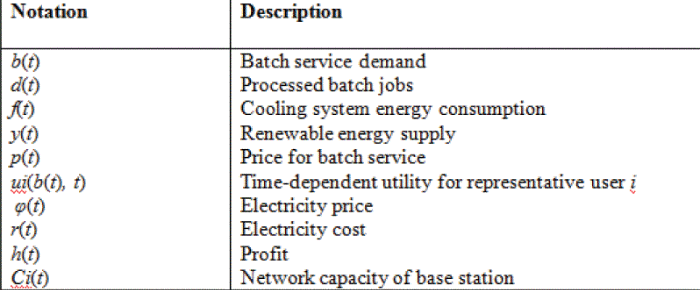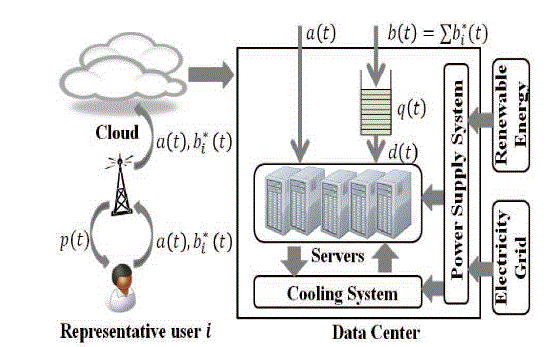ISSN ONLINE(2320-9801) PRINT (2320-9798)
ISSN ONLINE(2320-9801) PRINT (2320-9798)
| R.Saranya, G.Indra and Kalaivani.A Assistant Professor, Dept. of CSE., R.M.K.College of Engineering and Technology, Puduvoyal, Chennai, India. |
| Related article at Pubmed, Scholar Google |
Visit for more related articles at International Journal of Innovative Research in Computer and Communication Engineering
In this paper, we consider a wireless cloud computing system in which the wireless service provider operates a data center and provides cloud services to its subscribers at dynamic prices. We propose a joint optimization of scheduling and pricing decisions for delay-tolerant batch services to maximize the service provider’s long-term profit. Unlike the existing research on jointly scheduling and pricing that focuses on static or asymptotic analysis, we focus on a dynamic setting and develop a provably efficient Dynamic Scheduling and Pricing (Dyn-SP) algorithm which, without the necessity of predicting the future information, can be applied to an arbitrarily random environment that may follow an arbitrary trajectory over time. We prove that, compared to the optimal offline algorithm with future information, Dyn-SP produces a close-to-optimal average profit while bounding the job queue length in the data center. We perform a trace-based simulation study to validate Dyn-SP. Our results also indicate that, compared to the existing algorithms which neglect demand-side management, cooling system energy consumption, and/or the queue length information, Dyn-SP achieves a higher average profit while incurring (almost) the same average queueing delay.
Keywords |
| Cloud computing, Pricing, Profit maximization, Scheduling, Stochastic optimization. |
INTRODUCTION |
| Enabled by ubiquitous communications and low-cost mobile devices, the proliferation of digital data and growing demand for outsourcing the data to a cloud for processing has attracted a significant amount of attention from various IT companies, which advocate wireless cloud computing as one of the future gold mines [1]. While dynamically providing computing resources has been praised as an effective approach to reducing cloud operation costs and thereby increasing the service provider’s profit, recent studies show that combining dynamic resource provisioning with other operations such as load balancing can further enhance the system performance in terms of delay and energy consumption, giving the service provider an edge in the cloud computing market. |
| In this paper, we explore the interaction of dynamic pricing and service request scheduling and demonstrate that jointly optimizing these two decisions can significantly enhance the wireless service provider’s long-term profitability. Towards this end, we focus on a wireless service provider operating multiple base stations and one data center. Wireless subscribers outsource data-intensive and/or computing-intensive applications to the cloud managed by the service provider for processing. |
| Migrating such applications is mutually beneficial: users can access a large pool of high-performance computing resource anywhere and anytime; the wireless service provider is no longer only providing connectivity between users and the cloud service providers, but can enhance its profit by integrating cloud computing with wireless access services. Example applications that can, or even have to, be migrated to the cloud include real-time stream mining, scientific computing, visual search, and batch image processing. In general, these applications can be classified as interactive (i.e., delay-sensitive) and batch (i.e., delay-insensitive), and recent studies show that batch workloads typically account for 70% of all workloads in data centers [5].1 Focusing on dynamically scheduling and pricing for batch services that exhibit a high degree of scheduling flexibility due to the delay-tolerant nature, we aim at developing an efficient online algorithm to maximize the service provider’s long-term profit in a random environment to accurately predict in the long term impedes the derivation of a probably-efficient online scheduling and pricing algorithm. While hour-ahead information of the environment is readily available in practice accurately predicting the long-term information for all these parameters are very challenging, if not impossible. |
RELATED WORK |
Wireless cloud computing: |
| With a plethora of data and mobile applications, providing cloud-based services to wireless subscribers has attracted special attention from various wireless carriers (e.g., [1]), enabling new business opportunities. For instance, [14] proposes a new architecture migrating data-intensive and/or computation-intensive applications from mobile devices to the cloud, whereas advocate the migration of applications from energy-constrained mobile devices to the cloud. |
Energy-efficient data center operation: |
| There has been a growing interest in optimizing data center operation by cutting electricity bills and reducing energy consumption In particular, “power proportionality” via dynamically turning on/off servers based on the workloads has been recently studied and advocated as a promising approach to reducing data center energy costs . Combined with dynamic capacity provisioning, geographical load balancing can potentially provide additional benefits in cost saving response time reduction [12], and reducing the brown energy usage. |
Pricing: |
| Pricing has been widely used in engineering as a lever to enable efficient resource management in wireless networks congestion control technology adoption in communication markets, and demand coordination in smart grid . In cloud computing, proposes a pricing algorithm to regulate admission and perform resource allocation in such a way that the social welfare is maximized, and develops a computationally efficient pricing mechanism to enable fair competition for cloud resource. |
 |
| Cloud Using Data Center |
 |
| Parameters for Data Centres |
| The existing research on joint optimization of scheduling and pricing that focuses on a limiting regime (e.g., when the capacity goes to infinity) or a static game-theoretic setting for demand response in smart grid. Developing efficient online algorithms is a nontrivial task. |
PROPOSED ALGORITHM |
| The proposed Dyn-SP can be extended to multiple service classes and provide differentiated QoS in terms of the average delay. We proposed a provably-efficient online scheduling and pricing algorithm, Dyn-SP, which can be implemented based on the currently available information. We proved that, compared to the optimal offline algorithm with future information, Dyn-SP produces a closeto- optimal long-term profit while bounding the job queue length in the data center. |
 |
| System Architecture |
SERVICE PROVIDER |
| we consider a wireless service provider that provides cloud computing services to its subscribers. To keep the model succinct, we concentrate on delay-tolerant batch services while deferring the discussion of delay-sensitive interactive services to the extended model. |
| Base station : |
| The service provider owns N base stations, indexed each of which covers a certain area.4 We use Ci(t) ∈ [Cmin, Cmax] to represent the network capacity available for batch services provided by base station i at time t. The network capacity is time-varying for various reasons such as the users’ distances to the respective base station. The maximum amount of batch jobs that can be submitted by end users is constrained solely by the wireless network capacity provided by the base stations. |
| Cloud Provider: |
| Cloud Computing is been the process handled by service providers where the huge amount of both personal data as well as the official data is stored in a third party’s server. In such process the cloud is been promoted to online process where several procedures are been handled by the cloud servers. Conversion of a file to another format, resizing an image and many other processes can be done with a cloud system with proper pricing based on the performance of the server issued for the single process. |
| Cloud Consumer: |
| Common user who make use of the system facilities associated with the cloud system is been termed as a cloud consumer. The consumer uploads the file which has to be converted to another format into the cloud system from his profile. Before this the consumer has to register with the system by providing the necessary details and so that he can enter the system with proper login details. After entering the system the consumer can upload his file which has to be converted into zip file and can make use of the system. |
| his profile. Before this the consumer has to register with the system by providing the necessary details and so that he can enter the system with proper login details. After entering the system the consumer can upload his file which has to be converted into zip file and can make use of the system. |
 |
| Cloud Application Development |
| Data Center: |
| Data Center is the location where the cloud activities is been handled. The request from the user is been retrieved at the data center and the process is been completely done at this area. The request is been individually identified by the request id, file name and the content for each respective request id. The data center is the central processing area where the file uploaded by the user is been converted to the zip format and is been stored back to the database. |
| Dynamic Pricing: |
| Pricing for the procedure done at the cloud storage is been made statically in the existing cloud platforms. In our system the server performance is been evaluated only when the server is turned on for the process and also it includes the power consumption and other relevant energies. The total cost for a single process is been calculated and is been rendered to the cloud user. |
 |
| Login Page |
| The consumers are entering the user name Password for logging into the page. The Consumer Were using the Data Center. The pricing for the usage of the individual consumer usage were displayed Based on their usage requirements. |
| The Data usage by the individual consumer are Analyzed and the result display the usage of data, time of usage and other details. The pricing will be charged as per the requirements of the usage. Consumers were entering the personal details and finally the usage of data will be charged to the Individual consumer based on the usage. |
 |
| Registration of consumer |
 |
| Services of Data Centres |
CONCLUSION AND FUTURE WORK |
| A profit-maximizing wireless service provider “selling” cloud computing services to its subscribers. Focusing on batch services, we proposed a provably-efficient online scheduling and pricing algorithm, Dyn-SP, which can be implemented based on the currently available information. We proved that, compared to the optimal offline algorithm with future information, Dyn-SP produces a closet optimal long-term profit while bounding the job queue length in the data center. A simulation study was performed to demonstrate the effectiveness of Dyn-SP. Our results also indicated that, compared to the other algorithms which neglect demand-side management, cooling system energy consumption, or the queue length information, Dyn-SP achieves a higher average profit while incurring (almost) the same average delay. |
References |
|